Type Mild | ||
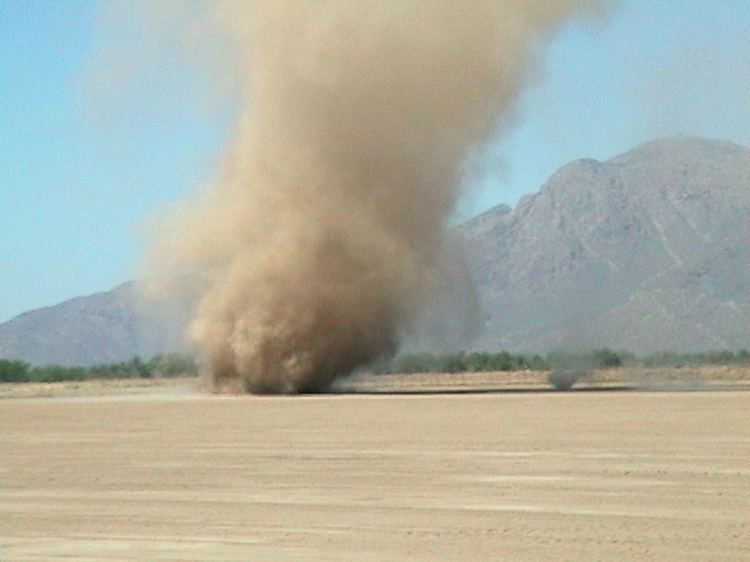 | ||
Sign Whirlwind of dust forming. Effect Dust spread in surrounding area, possibly coughing. | ||
A dust devil is a strong, well-formed, and relatively long-lived whirlwind, ranging from small (half a meter wide and a few meters tall) to large (more than 10 meters wide and more than 1000 meters tall). The primary vertical motion is upward. Dust devils are usually harmless, but can on rare occasions grow large enough to pose a threat to both people and property.
Contents
- Burning man pyramids dust devils
- Names
- Formation
- Intensity and duration
- Concerns
- Health
- Electrical activities
- Martian dust devils
- Related phenomena
- References
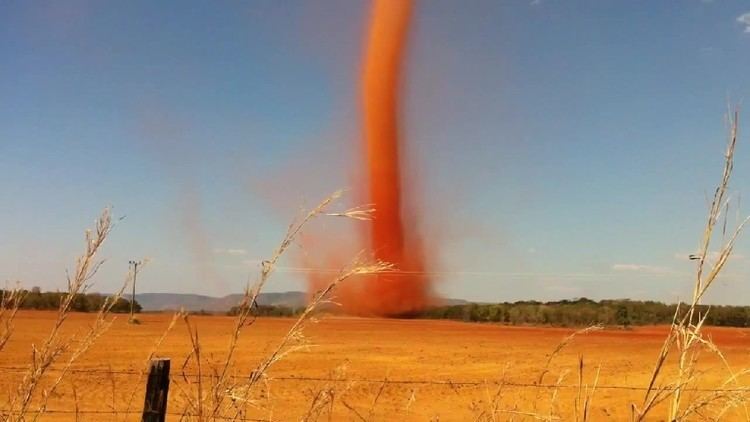
They are comparable to tornadoes in that both are a weather phenomenon of a vertically oriented rotating column of wind. Most tornadoes are associated with a larger parent circulation, the mesocyclone on the back of a supercell thunderstorm. Dust devils form as a swirling updraft under sunny conditions during fair weather, rarely coming close to the intensity of a tornado.
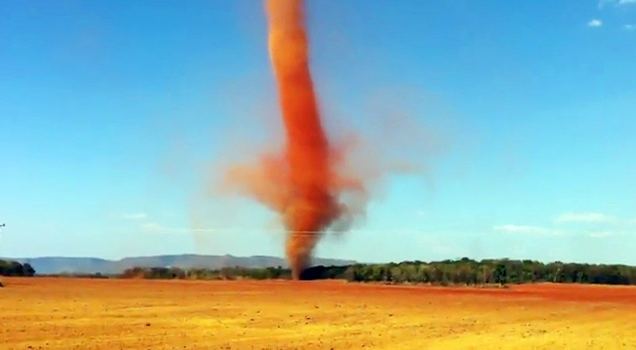
Burning man pyramids dust devils
Names
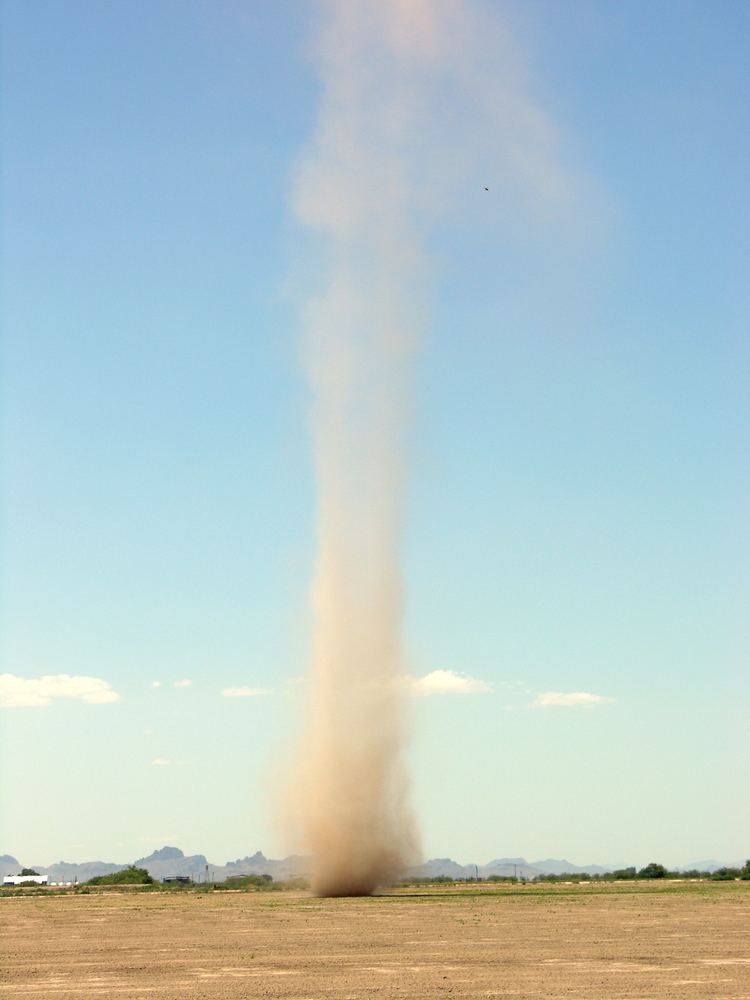
In the southwestern United States, a dust devil is sometimes called a "dancing devil". In Death Valley, California, it may be called a "sand auger" or a "dust whirl".
The Navajo refer to them as chiindii, ghosts or spirits of dead Navajos. If a chindi spins clockwise, it is said to be a good spirit; if it spins counterclockwise, it is said to be a bad spirit.
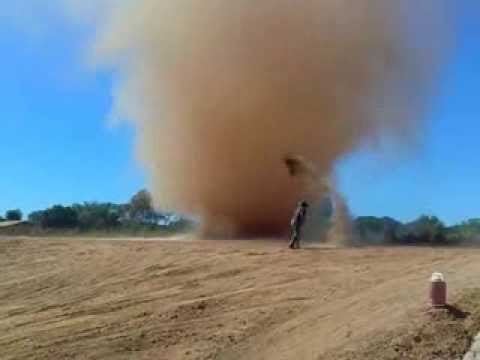
The Australian English term "willy-willy" or "whirly-whirly" is thought to derive from Yindjibarndi or a neighbouring language. In Aboriginal myths, willy-willies represent spirit forms. They are often quite scary spirits, and parents may warn their children that if they misbehave, a spirit will emerge from the spinning vortex of dirt and chastise them. There is a story of the origin of the brolga in which a bad spirit descends from the sky and captures the young being and abducts her by taking the form of a willy-willy.
In Saudi Arabia, Kuwait, Kazakhstan, and Jordan, they often reach hundreds of meters in height and are referred to as djin ("genies" or "devils").
Egypt has its fasset el 'afreet, or "ghost's wind". In Iran, this kind of wind is usually called "Gerd Baad", or "round wind".
Among the Kikuyu of Kenya, the dust devil is known as ngoma cia aka, meaning "women's devil/demon".
In Brazil, a dust devil is called redemoinho after moinho de vento ("windmill"). In some traditions, it contains a dancing Saci. Also, sometimes it is associated to local religion and beliefs. In Portugal it is known locally as remoinho (translated to continuous rotation).
In the US, when they occur in cities or urban scenes, they are sometimes called "Nevada tornadoes" or "Chicago tornadoes" because of Chicago's reputation for wind, despite dust devils being rare in Chicago.
Formation
Dust devils form when hot air near the surface rises quickly through a small pocket of cooler, low-pressure air above it. If conditions are just right, the air may begin to rotate. As the air rapidly rises, the column of hot air is stretched vertically, thereby moving mass closer to the axis of rotation, which causes intensification of the spinning effect by conservation of angular momentum. The secondary flow in the dust devil causes other hot air to speed horizontally inward to the bottom of the newly forming vortex. As more hot air rushes in toward the developing vortex to replace the air that is rising, the spinning effect becomes further intensified and self-sustaining. A dust devil, fully formed, is a funnel-like chimney through which hot air moves, both upwards and in a circle. As the hot air rises, it cools, loses its buoyancy and eventually ceases to rise. As it rises, it displaces air which descends outside the core of the vortex. This cool air returning acts as a balance against the spinning hot-air outer wall and keeps the system stable.
The spinning effect, along with surface friction, usually will produce a forward momentum. The dust devil is able to sustain itself longer by moving over nearby sources of hot surface air.
As available extreme hot air near the surface is channeled up the dust devil, eventually surrounding cooler air will be sucked in. Once this occurs, the effect is dramatic, and the dust devil dissipates in seconds. Usually this occurs when the dust devil is not moving fast enough (depletion) or begins to enter a terrain where the surface temperatures are cooler, causing unbalance.
Certain conditions increase the likelihood of dust devil formation.
Intensity and duration
On Earth, most dust devils are very small and weak, often less than 3 feet (0.9 m) in diameter with maximum winds averaging about 45 miles per hour (70 km/h), and they often dissipate less than a minute after forming. On rare occasions, a dust devil can grow very large and intense, sometimes reaching a diameter of up to 300 feet (90 m) with winds in excess of 60 mph (100 km/h) and can last for upwards of 20 minutes before dissipating.
Dust devils typically do not cause injuries, but rare, severe dust devils have caused damage and even deaths in the past. One such dust devil struck the Coconino County Fairgrounds in Flagstaff, Arizona, on September 14, 2000, causing extensive damage to several temporary tents, stands and booths, as well as some permanent fairgrounds structures. Several injuries were reported, but there were no fatalities. Based on the degree of damage left behind, it is estimated that the dust devil produced winds as high as 75 mph (120 km/h), which is equivalent to an EF0 tornado. On May 19, 2003, a dust devil lifted the roof off a two-story building in Lebanon, Maine, causing it to collapse and kill a man inside. In East El Paso, Texas in 2010, three children in an inflatable jump house were picked up by a dust devil and lifted over 10 feet (3 m), traveling over a fence and landing in a backyard three houses away. On December 31, 2014, during the set-up for a cookoff in the Rose Bowl Fan Fest area, a dust devil was caught on video. No one was seriously injured.
Concerns
Dust devils have been implicated in around 100 aircraft accidents. While many incidents were simple taxiing problems, a few have been fatal in-flight incidents. Dust devils are, however, considered major hazards among skydivers as they can cause a canopy to collapse with little to no warning, at altitudes considered too low to cutaway, and contribute to serious injury or death of parachutists.
Health
There is an endemic health issue in some arid areas, such as the southwestern United States, California, northwestern Mexico, Central America, and South America, called Valley fever. “Cocci” fungus grows naturally in alkaline soil and the fungus spores, that lie dormant and can be picked up by Dust Devils, are blown around. When a person breathes this it causes fungal pneumonia. While usually not a serious threat it can be dangerous to some people.
Electrical activities
Dust devils, even small ones (on Earth), can produce radio noise and electrical fields greater than 10,000 volts per meter. A dust devil picks up small dirt and dust particles. As the particles whirl around, they bump and scrape into each other and become electrically charged. The whirling charged particles also create a magnetic field that fluctuates between 3 and 30 times each second.
These electrical fields assist the vortices in lifting materials off the ground and into the atmosphere. Field experiments indicate that a dust devil can lift 1 gram of dust per second from each square metre (10 lb/s from each acre) of ground it passes over. A large dust devil measuring about 100 metres (330 ft) across at its base can lift about 15 metric tonnes (17 short tons) of dust into the air in 30 minutes. Giant dust storms that sweep across the world's deserts contribute 8% of the mineral dust in the atmosphere each year during the handful of storms that occur. In comparison, the significantly smaller dust devils that twist across the deserts during the summer lift about three times as much dust, thus having a greater combined impact on the dust content of the atmosphere. When this occurs, they are often called sand pillars.
Martian dust devils
Dust devils also occur on Mars (see dust devil tracks) and were first photographed by the Viking orbiters in the 1970s. In 1997, the Mars Pathfinder lander detected a dust devil passing over it. In the image shown here, photographed by the Mars Global Surveyor, the long dark streak is formed by a moving swirling column of Martian atmosphere. The dust devil itself (the black spot) is climbing the crater wall. The streaks on the right are sand dunes on the crater floor.
Martian dust devils can be up to fifty times as wide and ten times as high as terrestrial dust devils, and large ones may pose a threat to terrestrial technology sent to Mars.
Mission members monitoring the Spirit rover on Mars reported on March 12, 2005, that a lucky encounter with a dust devil had cleaned the solar panels of that robot. Power levels dramatically increased and daily science work was anticipated to be expanded. A similar phenomenon (solar panels mysteriously cleaned of accumulated dust) had previously been observed with the Opportunity rover, and dust devils had also been suspected as the cause.
Related phenomena
A fire whirl or swirl, sometimes called fire devils or fire tornadoes, can be seen during intense fires in combustible building structures or, more commonly, in forest or bush fires. A fire whirl is a vortex-shaped formation of burning gases being released from the combustible material. The genesis of the vortex is probably similar to that of a dust devil. As distinct from the dust devil, it is improbable that the height reached by the fire gas vortex is greater than the visible height of the vertical flames because of turbulence in the surrounding gases that inhibit creation of a stable boundary layer between the rotating/rising gases relative to the surrounding gases.
Hot cinders underneath freshly deposited ash in recently burned areas may sometimes generate numerous dust devils. The lighter weight and the darker color of the ash may create dust devils that are visible hundreds of feet into the air.
Ash devils form similar to dust devils and are often seen on unstable days in burn scar areas of recent fires.
Steam devils are phenomena often observed in the steam rising from power plants.
The same conditions can produce a snow whirlwind, although differential heating is more difficult in snow-covered areas.
Coal devils are common at the coal town of Tsagaan Khad in South Gobi Province, Mongolia. They occur when dust devils pick up large amounts of stockpiled coal. Their dark color makes them resemble some tornados.
